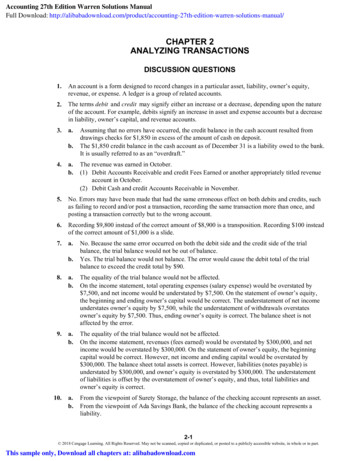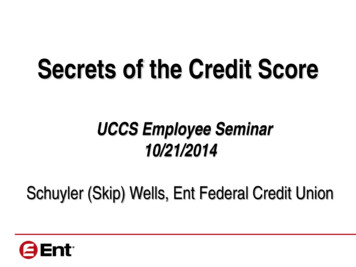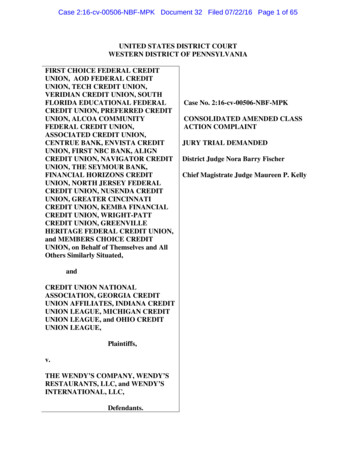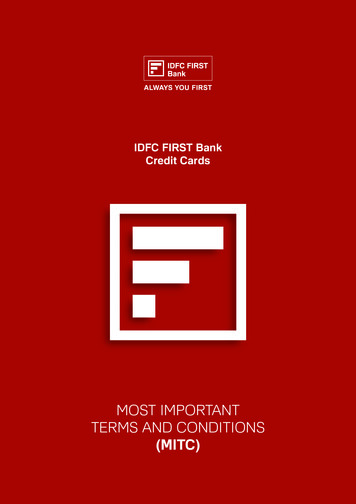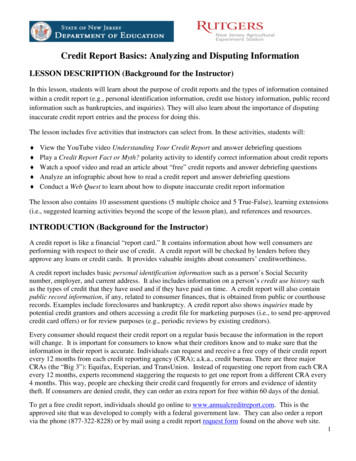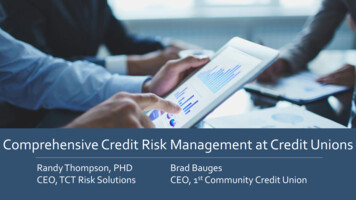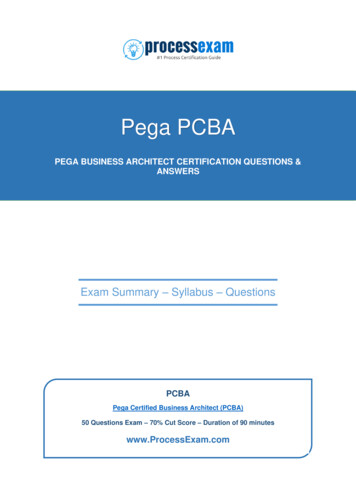
Transcription
ADVANCED CREDIT ANALYSISDAVID CARRKEVIN WEBB, CFA1/17/18
DisclaimerThe information presented in this presentation is intended to assist publicinvestment professionals. The content presented is informational and does notconstitute investment advice or the recommendation to invest in any or all of theinvestment instruments discussed. When choosing an investment instrument for apublic portfolio, the whole portfolio, investment policy, suitability, financial needsof the public agency and any associated risks should be considered. In addition,the information in this presentation is set to reflect the period in time in which itis presented and any changes that may affect any of the instruments discussed,such as legislation, reform or market conditions, or that may alter the relevancyof any of these instruments, will not be reflective in the post archival records. Insuch instances, viewers should be advised to use the information only as areference as no updates to the records will be made. Please consult theCalifornia Debt and Investment Advisory Commission’s publication Local AgencyInvestment Guidelines for any interpretive updates.
Agenda It’s All About Risk & RewardTreasury Yield Curve Default Risk Credit Spread Risk Downgrade Risk Limited Time, Staff & Resources: What to do? WolframAlpha/WSJ FRED SRI/ESG
Risk & Reward"You want a valve that doesn'tleak and you try everythingpossible to develop one. But thereal world provides you with aleaky valve. You have todetermine how much leaking youcan tolerate."Peter L. Bernstein. Against the Gods: The Remarkable Story of Risk (Kindle Locations 69-71). Kindle Edition.
The Yield Curve Framework
The Yield Curve Framework: Santa Monica
Ratings: LettersBond credit rating. (2016, January 15). In Wikipedia, The Free Encyclopedia. Retrieved 07:22, January 21, 2016, fromhttps://en.wikipedia.org/w/index.php?title Bond credit rating&oldid 691840556
Credit Risk Default Risk Credit Spread Risk the risk that the issuer will fail to satisfy the terms of theobligation with respect to the timely payment of interest andprincipal.The risk that an issuer's debt obligation will decline due toan increase in the credit spread is called credit spread risk.Downgrade Risk An unanticipated downgrading of an issue or issuerFrank J. Fabozzi. Fixed Income Analysis (Kindle Locations 780-821). Kindle Edition.
Default RatesStandard & Poors “Default, Transition, and Recovery: 2016 Annual Global Corporate Default Study And Rating Transitions”, Table 25 on Page 62.
Bloomberg DRSK (Merton Model)What is the 'Merton Model'The Merton model is an analysismodel – named aftereconomist Robert C. Merton –that is used to assess the creditrisk of a company’sdebt. Analysts at brokerage firmsand investors utilize the Mertonmodel to understand how capablea company is at meeting financialobligations, servicing its debt andweighing the general possibilitythat the company will go intocredit default. This model waslater built out by Fischer Blackand Myron Scholes to develop theBlack-Scholes pricing model.Main Driver of Default: Distance-to-DefaultThe DRSK GO framework for modeling default has its origins inthe structural model proposed by Robert Merton.1 In this model,arm is viewed as solvent as long as the value of the firm’s assetsis larger than the value of its liabilities. The issue is that the valueof the assets of the firm is not observable and must thus beinferred. The Merton model links the value of the assets to themarket cap and debt of a firm, both of which are observable. Thekey insight of the Merton framework is that the equity of thefirm can be viewed as a call option on the total assets of the firmwhere the strike price is equal to its liabilities. This allows us toinfer the value of the assets from the observed equity valueusing a BlackScholes option pricing approach. Source: Investopedia: sp and Bloomberg. On the Bloomberg terminal use DRSK GO .
Santa Monica Overview
Santa Monica Overview
Credit Spread Risk What is it?“Even in the absence of default, an investor is concernedthat the market value of a bond will decline and/or theprice performance of a bond will be worse than that ofother bonds. To understand this, recall that the price of abond changes in the opposite direction to the change in theyield required by the market. Thus, if yields in the economyincrease, the price of a bond declines, and vice versa.” “The risk that an issuer's debt obligation will decline due toan increase in the credit spread is called credit spread risk.” Frank J. Fabozzi. Fixed Income Analysis (Kindle Locations 784-793). Kindle Edition.
Credit Spread History
Credit Spread HistoryU.S. Department of the Treasury, 5-Year High Quality Market (HQM) Corporate Bond Par Yield [HQMCB5YRP], retrieved from FRED, Federal Reserve Bank of St. Louis; ry 4, 2018.Board of Governors of the Federal Reserve System (US), 5-Year Treasury Constant Maturity Rate [DGS5], retrieved from FRED, Federal Reserve Bank of St. Louis; https://fred.stlouisfed.org/series/DGS5, January 4, 2018.https://fred.stlouisfed.org/graph/?g hkhD
Credit Spread HistoryBofA Merrill Lynch, BofA Merrill Lynch US Corporate A Effective Yield [BAMLC0A3CAEY], retrieved from FRED, Federal Reserve Bank of St. Louis; https://fred.stlouisfed.org/series/BAMLC0A3CAEY, January 3, 2018.BofA Merrill Lynch, BofA Merrill Lynch US Corporate A Option-Adjusted Spread [BAMLC0A3CA], retrieved from FRED, Federal Reserve Bank of St. Louis; https://fred.stlouisfed.org/series/BAMLC0A3CA, January 3, 2018.https://fred.stlouisfed.org/graph/?g hjVl
Santa Monica Corporate Spreads
Santa Monica Corporate Spreads
Santa Monica OAS vs Default %
Transition Matrix What is it? “A popular tool used by managers togauge the prospects of an issue beingdowngraded or upgraded is a ratingtransition matrix. This is simply a tableconstructed by the rating agencies thatshows the percentage of issues that weredowngraded or upgraded in a given timeperiod. So, the table can be used toapproximate downgrade risk and defaultrisk.”Frank J. Fabozzi. Fixed Income Analysis (Kindle Locations 828-830). Kindle Edition.
Transition Rates: 5 YearStandard & Poors “Default, Transition, and Recovery: 2016 Annual Global Corporate Default Study And Rating Transitions”, Table 36 on Page 83.http://media.spglobal.com/documents/SPGlobal Ratings Article 13 April 2017 Annual Corporate Default Study and Rating Transitions.pdf
A Ratings Digression Part 1Lehman Brothers Credit Rating HistorySource: Bloomberg
A Ratings Digression Part 2“The ratings agencies had given their AAA rating, normallyreserved for a handful of the world’s most solvent governmentsand best-run businesses, to thousands of mortgage-backedsecurities, financial instruments that allowed investors to bet on thelikelihood of someone else defaulting on their home. The ratingsissued by these companies are quite explicitly meant to bepredictions: estimates of the likelihood that a piece of debt willgo into default. Standard & Poor’s told investors, for instance,that when it rated a particularly complex type of security knownas a collateralized debt obligation (CDO) at AAA, there was onlya 0.12 percent probability— about 1 chance in 850— that itwould fail to pay out over the next five years. In fact, around 28 percent of the AAA-rated CDOs defaulted,Silver, Nate (2012-09-27).according to S&P’s internal figures. This is just about asThe Signal and the Noise:complete a failure as it is possible to make in a prediction:trillions of dollars in investments that were rated as being almost Why So Many Predictions Failbut Some Don't (pp. 20-21).completely safe instead turned out to be almost completelyPenguin Group US. Kindleunsafe. It was as if the weather forecast had been 86 degreesEdition.and sunny, and instead there was a blizzard.”
WolframAlpha Computational Knowledge Engine www.wolframalpha.com
What is a ComputationalKnowledge Engine?
So What? What can it do?
Hmmm What else?
I bet it doesn’t know football!Source: WolframAlpha on 1/4/18http://www.wolframalpha.com/input/?i compare the Rams and Falcons&rawformassumption %7B%22C%22, %22Rams%22%7D -%3E %7B%22NFLTeam%22%7D
WolframAlpha & Credit AnalysisSource: WolframAlpha on 1/4/18http://www.wolframalpha.com/input/?i AAPL vs IBM vs MSFT
WolframAlpha & Credit AnalysisSource: WolframAlpha on 1/4/18http://www.wolframalpha.com/input/?i AAPL vs IBM vs MSFT
WolframAlpha & Credit AnalysisSource: WolframAlpha on 1/4/18http://www.wolframalpha.com/input/?i AAPL vs IBM vs MSFT
Equity Analysts Rating s as of 1/3/18
Equity Analysts Rating Analysishttp://quotes.wsj.com/IBM/research-ratings as of 1/3/18
Equity Analysts Rating s as of 1/3/18
Equity Analysts Rating AnalysisSource: Bloomberg
SRI/ESG Considerations“A critical factor in the financial performance of investments is theinvestor’s ability to identify drivers of the expected risk and return ofinvestments. Financial analysts and portfolio managers are expected to befamiliar with the financial factors that drive the value of an investment.However, issues that are difficult to measure in monetary terms and that donot form part of traditional financial metrics also affect the risk and returnof investments—at times, decisively. In general, they are referred to asenvironmental, social, and governance (ESG) issues.”Environmental, Social, and Governance Issues in Investing: A Guide for Investment Professionals; Usman Hayat, CFA & Matt Orsagh, CFA, CIPM; Codes, Standards, and PositionPapers; October, 2015. n11.1
Awareness is Growing“A well-known indicator of the increasing awareness of ESG issues is the rapidlygrowing list of signatories to the United Nations–supported Principles forResponsible Investment (PRI), the principal framework for investors who wish tointegrate the consideration of ESG issues into their investment decision making.According to PRI, the assets under management (AUM) of its signatories havegrown from less than 6 trillion at PRI’s launch in 2006 to nearly 60 trillion as ofApril 2015 .”Environmental, Social, and Governance Issues in Investing: A Guide for Investment Professionals; Usman Hayat, CFA & Matt Orsagh, CFA, CIPM; Codes, Standards, and PositionPapers; October, 2015. n11.1
ESG Resources (CFA ture/Pages/esg.aspx ESG CFA Institute July 2017 Survey e/Documents/ESG Survey Report July 2017.pdf. Global Perceptions Survey re/Documents/RGB Digital%20brochure.pdf
SRI/ESG MetricsSource: Bloomberg.
% Women by Sustainalytics vs ESG (1/3/18)Source: Bloomberg. Analysis and Graphs by David Carr & Kevin Webb, CFA
SRI/ESG Metrics by Moody Rating (1/3/18)Source: Bloomberg. Analysis and Graphs by David Carr & Kevin Webb, CFA
DisclaimerThis presentation is intended to discuss broad investment principles and is should not be viewed as the Firm acting as anadvisor to the Municipal Entity or Obligated Person. The Firm does not owe a fiduciary duty pursuant to Section 15B of the ExchangeAct to the Municipal Entity or Obligated Person with respect to the information and material contained in this presentation. TheMunicipal Entity or Obligated Person should discuss any information and material contained in this communication with any and allinternal or external advisors and experts that the Municipal Entity or Obligated Person deems appropriate before acting on thisinformation or material.While care has been taken in the preparation of the Presentation presented herein, information has been obtainedfrom sources believed to be reliable but Cantor does not make any representations or warranties, express or implied, as to theaccuracy, completeness, or appropriateness of the information contained herein. Additional information is available upon request. ThisPresentation may contain forward-looking statements, which give current expectations of future activities and performance. Any or allforward-looking statements in this Presentation may prove to be incorrect and such statements may be affected by inaccurateassumptions or by known or unknown risks and uncertainties. Cantor does not undertake any obligation to revise such forward-lookingstatements to reflect the occurrence or non-occurrence of events or circumstances, whether changed, anticipated, or unanticipated.Presentations have been prepared by sales personnel who receive compensation based upon various factors, including,but not limited to, the overall profitability of Cantor. Cantor and its partners, officers, directors, or employees may sell to, or purchasefrom, customers securities, commodity futures, derivatives, or other financial instruments on a principal basis or as agent for anotherperson, and may have interests different or adverse to the interests of the recipient of this communication. Cantor’s representatives,other than the author of this communication, may provide oral or written market commentary or trading strategies to Cantor’s clientsthat reflect opinions that are contrary to the opinions expressed in this communication or others at Cantor.You are cautioned that there is no universally accepted method for analyzing financial instruments. Past performance isnot indicative of future results. As a matter of policy, Cantor does not give tax, accounting, regulatory or legal advice to clients, andthe information contained herein should not be considered to constitute such advice. Cantor strongly urges that the recipient seekindependent legal, regulatory, accounting and tax advice regarding the contents of this communication and to make an independentdetermination regarding the suitability of any strategy or instrument identified herein. Cantor disclaims any and all liability for anyloss that may arise from use of the information contained herein.
Credit Risk Default Risk the risk that the issuer will fail to satisfy the terms of the obligation with respect to the timely payment of interest and principal. Credit Spread Risk The risk that an issuer's debt obligation will decline due to an increase in the credit spread is called credit spread risk.

